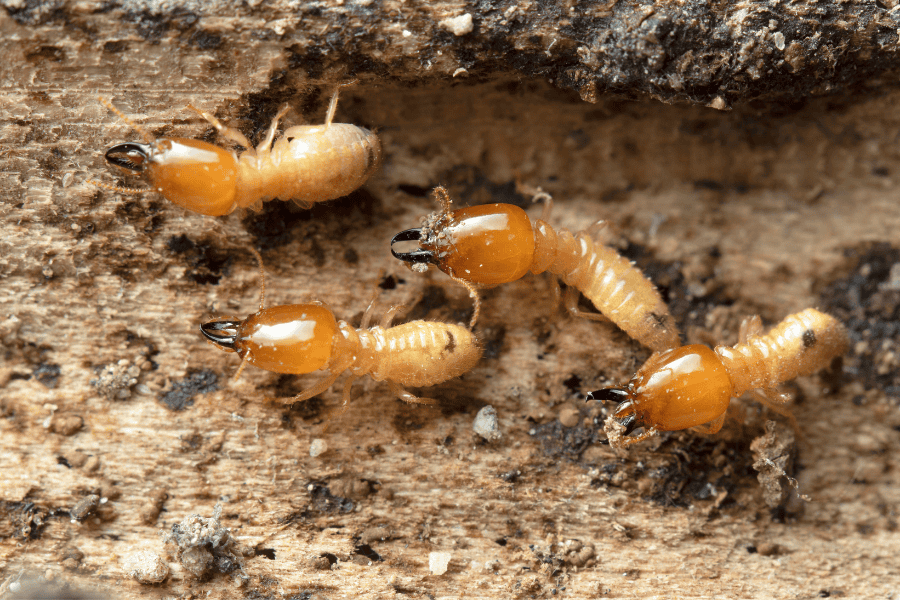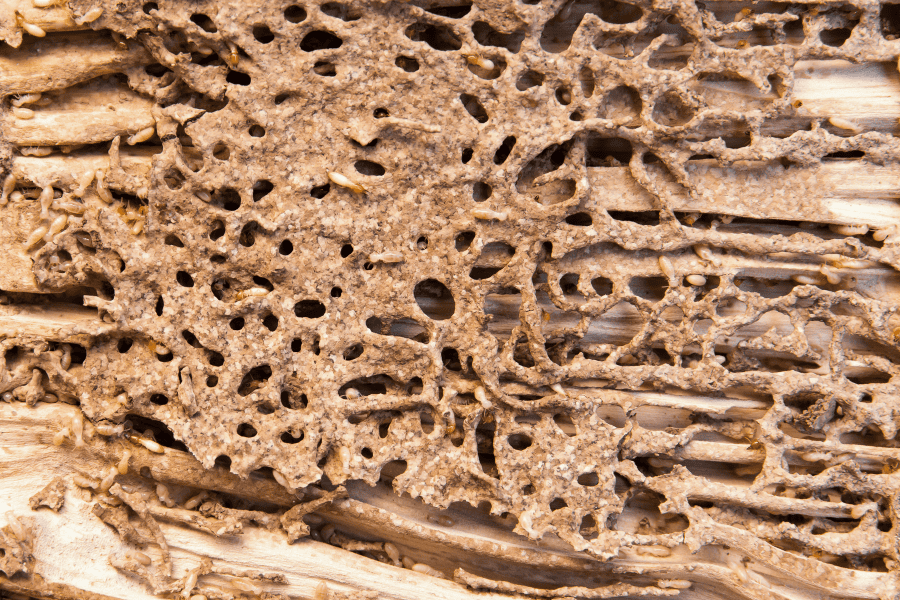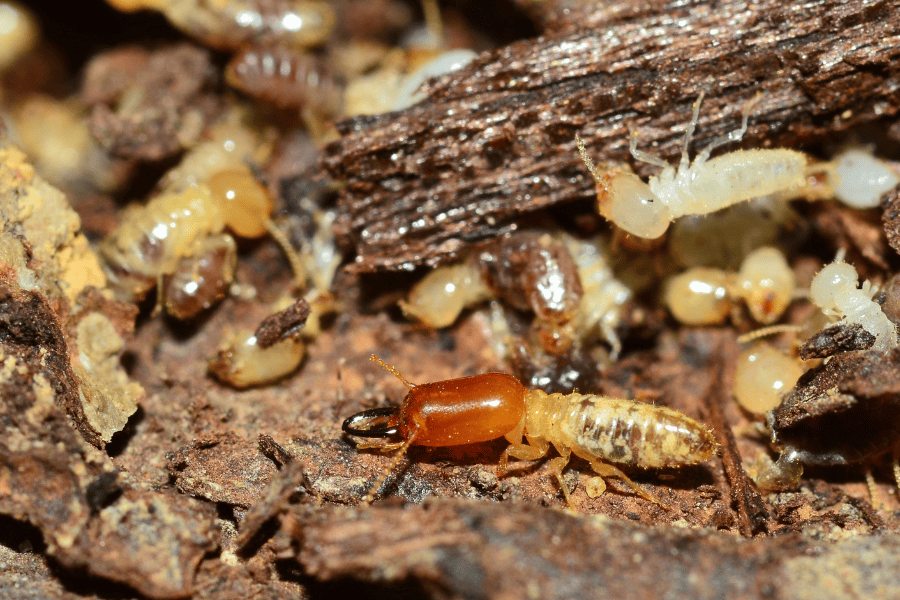READY TO GET STARTED?
REQUEST A FREE ESTIMATE
Fill out the form below or call (336) 226-1448 for a free, no-obligation estimate.

Termites may be small, but their impact on homes across North Carolina is anything but insignificant. Burlington homeowners need to be on high alert, as our warm, humid climate provides the perfect environment for these destructive pests. Termites are silent invaders, often causing extensive damage long before they’re even noticed. The good news? With early detection and proactive measures, you can protect your home and avoid costly repairs. Here’s what you need to know about termite control in Burlington before it’s too late.
Termites feed on cellulose, the main component of wood, which makes your home’s foundation, insulation , and even furniture a prime target. The damage they cause can compromise your home’s structural integrity, leading to repairs that cost homeowners across the U.S. billions of dollars annually. Termites don’t discriminate either; even brick and concrete homes are at risk if they contain wooden structures or supports.
Due to Burlington’s climate, termite activity is prevalent year-round. Subterranean termites are the most common species in the area, building colonies underground and tunneling into homes undetected. This is why early detection and prevention are so crucial. By the time termites leave visible signs of their presence, significant damage may already have been done.
Catching a termite infestation early can save you time, money, and stress. Here are some common signs to watch out for in your Burlington home:
If you notice any of these signs, it’s time to act quickly. Termites won’t go away on their own, and delaying treatment will only allow the problem to worsen.
The best way to handle termites is to stop them before they infest your home. Here are some practical tips:
Termites are a serious threat to Burlington homeowners, but with the right knowledge and proactive measures, you can keep them from damaging your home. If you suspect termite activity or want to take preventative steps, don’t wait. Contact a trusted pest control provider today for a thorough inspection and effective termite control plan. Your home is one of your biggest investments – make sure it’s protected!

Termites may be small, but the damage they can cause to your home is anything but. With warmer weather in spring and summer, these pests become more active, particularly in places like North Carolina where the climate is ideal for their colonies to thrive. Protecting your home from termites is essential to maintaining its structural integrity and avoiding costly repairs. This comprehensive guide to termite control near me will walk you through what you need to know about termites, how to identify early warning signs, and practical steps to keep them at bay this season.
Termites are wood-eating insects that live in colonies and can chew through wooden structures, flooring, and even wallpaper. The most common types in North Carolina are subterranean termites, which thrive in moist environments and can silently damage your property. Unlike other pests, termites don’t just infest; they destroy.
What makes them particularly challenging is that their activity often goes unnoticed until significant damage has already been done. This means prevention and early detection are crucial for homeowners.
Termites are most active during spring and summer due to the warmth and humidity that North Carolina provides. During these seasons, reproductive termites, also known as swarmers, search for new locations to establish colonies. If they find your home or yard hospitable, it could spell trouble.
Subterranean termites also require moisture to survive, making water sources such as leaky pipes, clogged gutters, and standing water attractive to these pests. The combination of environmental factors and increased termite activity makes spring and summer critical times for homeowners to take preventive action.
Early detection is key to avoiding termite damage. Look out for these common signs of termite activity:
If you spot any of these signs, it’s time to take immediate action.
Keeping your yard tidy and less appealing to termites can go a long way in protecting your home. Here’s how you can do it:
Since termites thrive in moist environments, moisture management is a simple yet effective strategy:
One of the best ways to stay ahead of termites is to inspect your home regularly:
When it comes to termites, being proactive is your best defense. By recognizing warning signs, managing moisture, maintaining your yard, and scheduling regular inspections with termite control near me, you can significantly reduce the risk of a termite infestation. Spring and summer are ideal times to take these steps to your home for years to come.
For homeowners in North Carolina, expert guidance in termite control is just a call away. Protect what matters most by contacting a local pest control professional who understands the unique needs of your region. Don’t wait for termites to make themselves at home in your home!

When most people think of pests, they picture mosquitoes buzzing around in the summer or rodents sneaking indoors to escape the winter cold. However, there is one often-overlooked pest that can cause serious long-term damage if left unchecked: termites. With March approaching, Termite Awareness Month, now is a perfect opportunity for homeowners in North Carolina to prioritize termite inspections. By understanding these silent destroyers and taking proactive steps, you can protect your home from potentially costly damage.
While most pests might take a break during colder months, termites are active year-round, especially given North Carolina’s mild climate. These tiny invaders don’t hibernate but continue to feed on wood, putting your home at risk. Unlike ants or spiders, termites work silently, often causing damage before you even realize they’re there.
Ignoring the threat can result in significant damage, with termites quietly consuming the wooden structures of your home. By the time their presence becomes noticeable, the damage may be extensive and expensive to repair. That is why scheduling a termite inspection should be a priority for homeowners, even during winter.
Identifying a termite infestation early can save you from costly repairs. Despite their ability to hide, termites leave telltale signs that can alert you to their presence.
Knowing these signs is helpful, but identifying an infestation early often requires the expertise of a professional. This is where professional termite inspections come in. A trained pest control technician can conduct a thorough inspection, identifying signs of termites in hard-to-reach or hidden areas like attics and crawl spaces.
Professional inspections are crucial because termites can remain active in areas that are not easily visible. A licensed pest control expert can uncover hidden damage and ensure your home remains protected.
The best way to protect your home from termites is to prevent them from entering in the first place. Here are a few simple yet effective prevention tips:
Termites may be silent, but their impact is anything but. For North Carolina homeowners, understanding the importance of early termite inspections and staying vigilant against these pests is vital. By recognizing the signs of an infestation early and taking preventive measures, you can protect your home from the costly damage termites can cause.
Remember, when it comes to termites, an ounce of prevention is worth a pound of cure. Consider scheduling a professional inspection today with a licensed pest control company near you. Secure your home’s future by learning more about how you can protect it from termites and other pests.
We’re moving in the cooler season, which means termites might not be on your mind right now. But there is no better time to begin thinking about your termite protection plan! There are several termite protection treatments and plans to consider, but if you’re looking for 24/7, 365-day protection, the Sentricon Always Active Bait Station could be the best choice for you. Let’s go over the benefits of this eco-friendly termite control option that might just be perfect for your home.
Sentricon is a highly effective, environmentally responsible treatment option for preventing and eliminating termites. These bait stations are placed strategically around the perimeter of your property and offer 24/7/365 termite protection for your home by eliminating entire termite colonies. Here are some other great benefits to the Sentricon bait stations:
Ready for an always on termite protection plan? Give our team a call today for a free quote!

Subterranean termites are a common type of termite that can cause significant damage to your home if left untreated. These termites typically live underground and build their nests in the soil. There are several termite treatment options out there to help keep termites under control, including the Sentricon Always Active® system. Here is more information on subterranean termites, along with ways to prevent and eliminate them.
Remember to look out for signs of termite activity, such as the presence of mud tubes or damaged wood, and schedule regular inspections with your local pest control company to catch any infestations early.